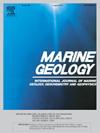卡斯卡迪亚边缘逆冲脊和斜坡盆地沉积物磁化率的成岩蚀变追踪(ODP站点1249和1252)IODP网站(U1325)
IF 2.2
3区 地球科学
Q2 GEOSCIENCES, MULTIDISCIPLINARY
引用次数: 0
摘要
我们研究了Cascadia边缘(海洋钻探计划地点1249和1252)水合物脊的沉积物岩心记录;利用x射线荧光(XRF)岩心扫描的Zr/Rb重矿物代理,确定了原生碎屑磁化率(κ)的区间,并预测了成岩作用导致硫化氢溶解磁铁矿的区间。我们还测量了总硫(TS)含量、粒度分布、总有机碳(TOC)含量和磁性矿物组合,以进一步限制成岩作用对κ的作用。了解κ如何能够更好地表征海洋环境中碎屑和成岩信号的不同影响,对于理解生物地球化学循环和古环境变化记录具有重要意义。坡面盆地Site 1252上部100 m包含多个区间(>;κ的降低与TS含量升高相关,与磁铁矿的溶解和黄铁矿、单硫化铁和/或单质硫的沉淀相一致。同样,在另一个斜坡盆地站点U1325,由于硫化物地层,κ较低,TS在24 ~ 51 mbsf之间升高。在两个斜坡盆地位点,这些低κ区间对应于高TOC,表明有机碎屑硫酸盐还原(OSR)可能是这些位点上κ的成岩改变的主要驱动因素。U1325位点的高TS:TOC比值表明硫酸盐-甲烷过渡带(SMTZ)迁移过程中甲烷(AOM)的厌氧氧化可能导致κ的改变。相比之下,在水合物脊顶部的甲烷渗漏点1249的上部90 m内,κ几乎完全被成岩过程改变,大部分低κ可以用高硫化铁形成来解释,而一些区间则受到磁性硫化铁沉淀的影响,这些沉淀维持甚至增加了κ。该地点存在丰富的甲烷渗漏和天然气水合物,以及化学合成的海底动物,表明硫化物被释放到水柱中,AOM而不是OSR驱动了该地点的κ的成岩改变。总体而言,斜坡盆地站点的κ表现出受TOC含量影响的偶发性变化,可能是由海洋初级生产力和沉积速率的变化驱动的,而渗漏站点的κ表现出持续改变,TS含量较低,与TOC无关。甲烷渗漏环境可能会经历硫化氢向水柱的损失和海底渗漏动物对硫化氢的氧化,这限制了沉积物中可以沉淀的固相硫(黄铁矿、单硫化铁、单质硫)的数量。与此相反,埋置SMTZ在斜坡盆地位置的迁移导致沉积物中硫降水增强。磁法与地球化学相结合的方法揭示了硫化物与沉积物柱的成岩生成途径和停留时间,最终控制了海洋沉积物中κ的成岩损失类型和程度。这种方法在参考区间/地点不变、磁性矿物学一致、粘土-淤泥颗粒尺寸不变的环境中效果最好。本文章由计算机程序翻译,如有差异,请以英文原文为准。
Tracking diagenetic alteration of magnetic susceptibility in thrust ridge and slope basin sediments of the Cascadia margin (ODP Sites 1249 and 1252; IODP Site U1325)
We investigated sediment core records from the Cascadia Margin (Ocean Drilling Program Sites 1249 and 1252 at Hydrate Ridge; Integrated Ocean Drilling Program Site U1325 offshore Vancouver Island) using a Zr/Rb heavy mineral proxy from X-ray fluorescence (XRF) core scanning to identify intervals of primary detrital magnetic susceptibility (κ) and predict intervals where diagenesis caused magnetite dissolution by hydrogen sulfide. We also measured total sulfur (TS) content, grain size distributions, total organic carbon (TOC) content, and the magnetic mineral assemblage to further constrain the role of diagenesis on κ. Understanding how κ can be used to better characterize the varied effects of detrital and diagenetic signals in marine settings is important for understanding biogeochemical cycling and records of paleoenvironmental change. The upper 100 m of slope basin Site 1252 contains multiple intervals (> 90 m total) of decreased κ correlated with elevated TS content, consistent with dissolution of magnetite and precipitation of pyrite, iron monosulfides, and/or elemental sulfur. Similarly at the other slope basin site, Site U1325, κ is lower and TS is elevated in the interval between 24 and 51 mbsf, due to sulfide formation. At both slope basin sites, these low κ intervals correspond with high TOC, suggesting the possibility that organoclastic sulfate reduction (OSR) is likely a major driver of diagenetic alteration of κ at these sites. High TS:TOC ratios at Site U1325 suggests anaerobic oxidation of methane (AOM) during sulfate-methane transition zone (SMTZ) migration may have contributed to alteration of κ. In contrast, within the upper 90 m of Site 1249, a methane seep site at the summit of Hydrate Ridge, κ is almost entirely altered by diagenetic processes, with much of the low κ explained by a high degree of iron sulfide formation, while some intervals are affected by precipitation of magnetic iron sulfides that maintain or even increase κ. The presence of abundant methane seepage and gas hydrate as well as chemosynthetic seafloor fauna at this site, suggests that sulfide is released to the water column and AOM, rather than OSR, drives diagenetic alteration of κ at this site. Overall, the slope basin sites show episodic variation of κ that is influenced by TOC content, likely driven by changes in marine primary productivity and sedimentation rate, while the seep site shows consistently altered κ with lower TS content and no correlation with TOC. Methane seep environments likely experience loss of hydrogen sulfide to the water column and oxidation of hydrogen sulfide by seafloor seep fauna, which limits the amount of solid phase sulfur (pyrite, iron monosulfides, elemental sulfur) that can be precipitated within the sediments. In contrast, the migration of a buried SMTZ at slope basin sites results in enhanced sulfur precipitation within the sediments. This integrated magnetic and geochemical approach reveals the diagenetic production pathway and residence time of sulfide with the sediment column ultimately controls the style and degree of diagenetic loss of κ in marine sediments. This approach works best in environments with unaltered reference intervals/sites, consistent magnetic mineralogy, and clay-to-silt grain sizes.
求助全文
通过发布文献求助,成功后即可免费获取论文全文。
去求助
来源期刊

Marine Geology
地学-地球科学综合
CiteScore
6.10
自引率
6.90%
发文量
175
审稿时长
21.9 weeks
期刊介绍:
Marine Geology is the premier international journal on marine geological processes in the broadest sense. We seek papers that are comprehensive, interdisciplinary and synthetic that will be lasting contributions to the field. Although most papers are based on regional studies, they must demonstrate new findings of international significance. We accept papers on subjects as diverse as seafloor hydrothermal systems, beach dynamics, early diagenesis, microbiological studies in sediments, palaeoclimate studies and geophysical studies of the seabed. We encourage papers that address emerging new fields, for example the influence of anthropogenic processes on coastal/marine geology and coastal/marine geoarchaeology. We insist that the papers are concerned with the marine realm and that they deal with geology: with rocks, sediments, and physical and chemical processes affecting them. Papers should address scientific hypotheses: highly descriptive data compilations or papers that deal only with marine management and risk assessment should be submitted to other journals. Papers on laboratory or modelling studies must demonstrate direct relevance to marine processes or deposits. The primary criteria for acceptance of papers is that the science is of high quality, novel, significant, and of broad international interest.
 求助内容:
求助内容: 应助结果提醒方式:
应助结果提醒方式:


